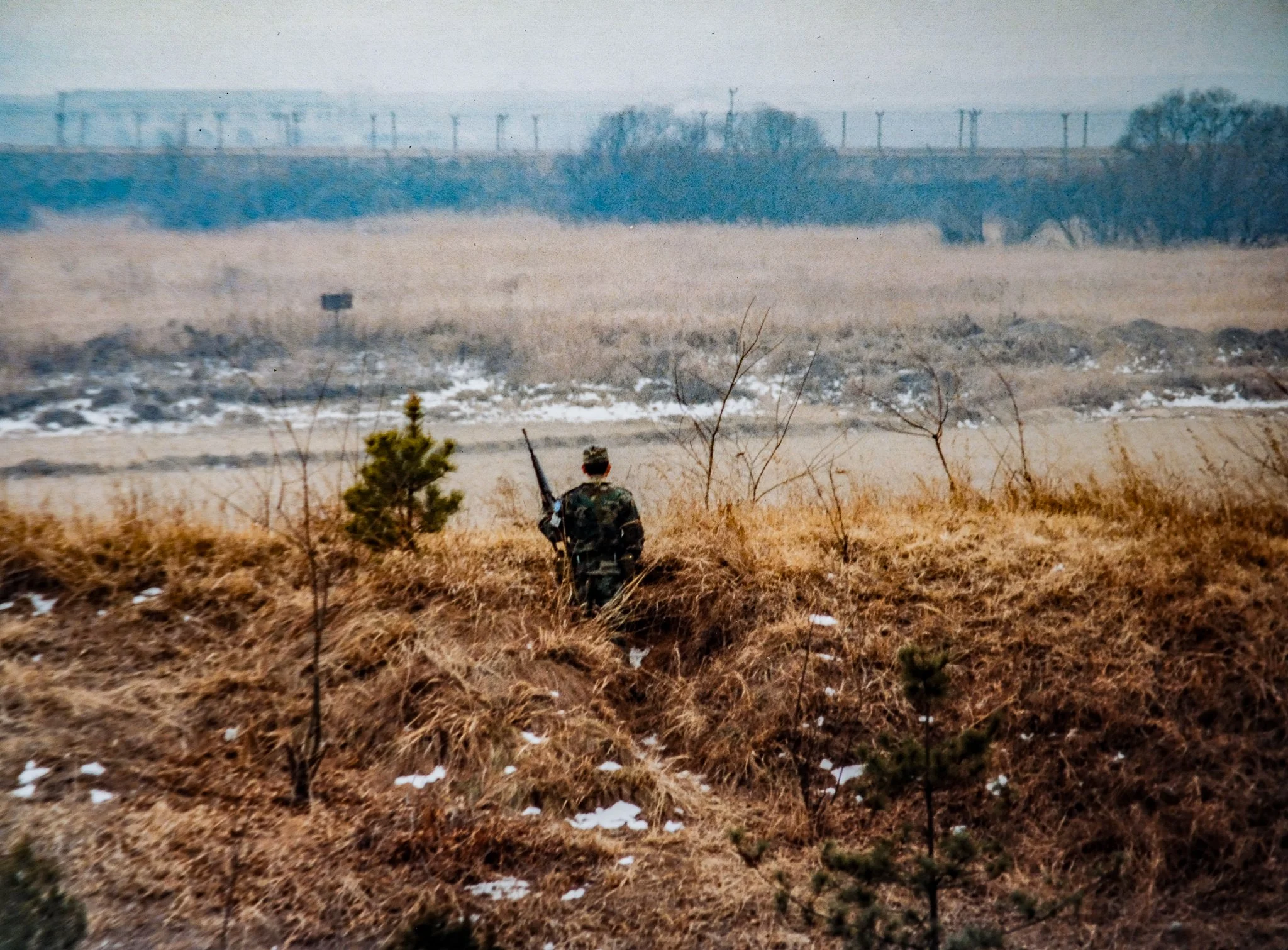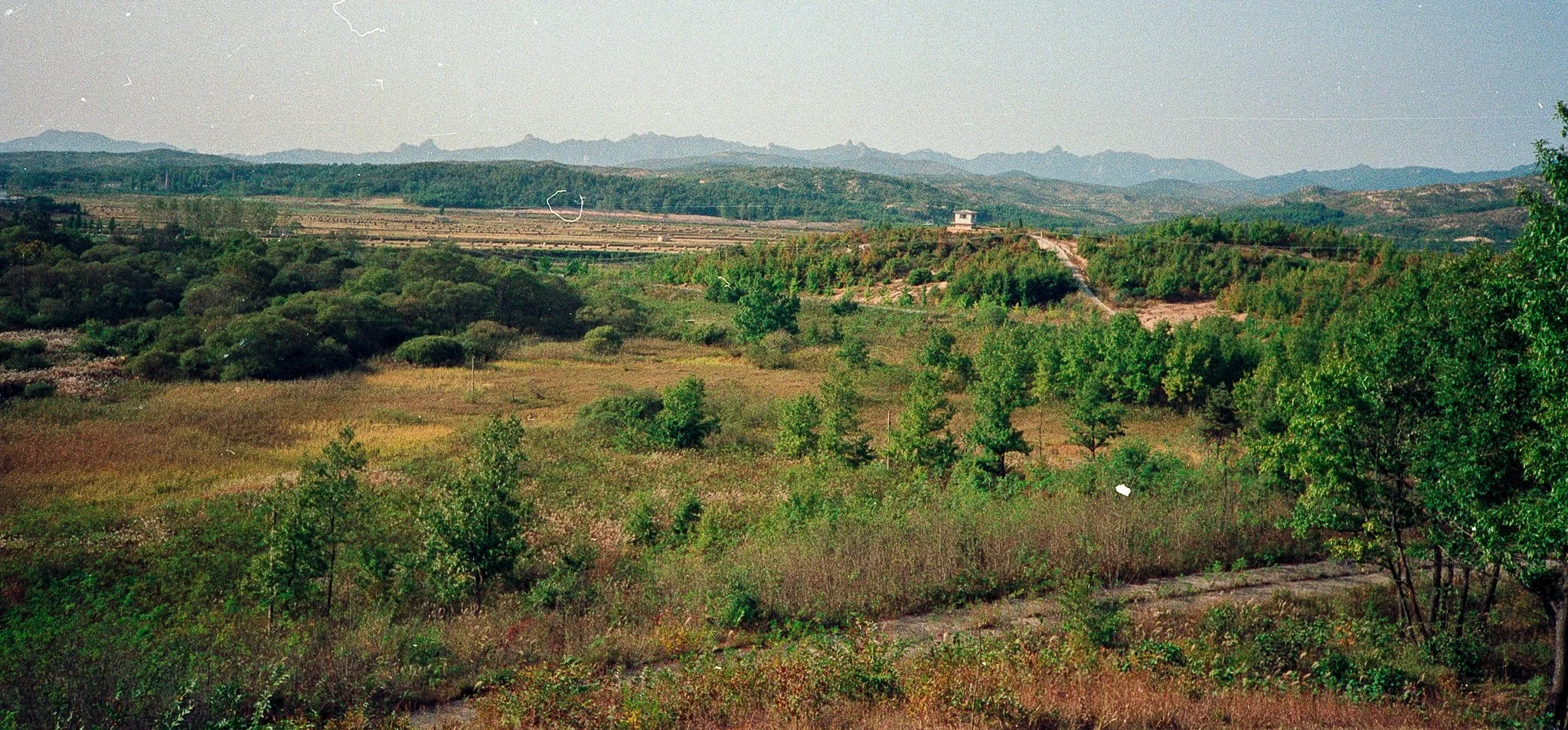Militarisation and Biodiversity: Ecological Politics in the Korean DMZ
By Roland Bleiker
11 August 2025
Context of this Blog
This blog reviews the book Eleana J. Kim Making Peace with Nature: Ecological Encounters Along the Korean DMZ (Duke University Press, 2022). The review was commissioned by and is forthcoming with The Journal of Development Studies.
I am writing this in the context of four decades of interest in Korea, starting with a two year period (1986-1988) that I spent as a Swiss Army Officer in Panmunjom, the Korean DMZ, as a member of the Neutral Nations Supervisory Commission.
For links to my ongoing work on security and visuality in Korea see here.
All photographs below are mine and taken during my work in the DMZ.
The Korean Demilitarized Zone (DMZ) holds a prominent place in the global imaginary. Images of the heavily fortified Military Demarcation Line regularly circulate in the media. They symbolise the lingering trauma of the Korean War (1950-1953), the division of the peninsula and the ongoing Cold-War confrontation between two ideologically opposed sides. Prominent summit meetings are often held in the border town of Panmunjom, as in 2019 between the leaders of South Korea, North Korea and the United States: Moon Jae-in, Kim Jong-un and Donald Trump. Popular culture further mythologises the border-zone. Consider the prominent movie Joint Security Area by Park Chan-wook (2000). Some of us might even have been on one of the adventure trips that are offered in Seoul and take tourists to the southern part of the DMZ.
Established with the Armistice in 1953, the DMZ is a four-kilometre-wide stretch of land that cuts across and divides the entire 250-kilometer-wide Korean peninsula. It is demilitarised in the sense that the Armistice prohibited the warring parties from stationing heavy artillery inside the DMZ. But, paradoxically, the area adjacent to the DMZ has become one of the most militarized zones in the world. More than a million troops face each other across the dividing line, including 600,000 South Korean and American soldiers on the southern side.
Eleana J. Kim’s fascinating book provides us with a different picture of the DMZ. She focuses not on the volatile stand-off between North and South Korea, but on the unintended consequences of this highly militarised zone: the creation of a unique biodiverse space.
More than 70 years of militarisation have banished much human interference from the DMZ and, in doing so, allowed nature to flourish and protect many endangered species. Diplomatic failure became an environmental blessing, as Kim (2022: 12) puts it. Her book documents an environmental movement that has steadily grown over the past 25 years. She does so by building on previous scholarly contributions that have provided us with more nuanced understandings of the Korean borderzone (including Gelézeau et al 2013 and Kim 2014).
Making Peace with Nature revolves around three themes: ponds, birds and landmines.
In a chapter on ponds, Kim describes agricultural activities in areas where security restrictions have forced farmers to use pre-modern irrigation techniques. The resulting ponds – or dumbeong – have created ecologies that allow endangered species to flourish: not just those that get regular public attention – such as cranes and bears and tigers - but also less charismatic and more microscopic invertebrate life-forms.
In a chapter on birds, Kim highlights the importance of avian flyways that crisscross the DMZ and form important links in broader routes for migratory birds across East Asia and Australasia.
In a chapter on landmines she outlines their long and paradoxical history. First introduced during the Korean war, landmines have created much human suffering. They get dislodged during floods and landslides and have killed or injured residents and farmers. But landmines have also protected nature from human interference, allowing forms of non-human life to flourish in ways that would otherwise not be possible.
Kim is an anthropologist and jokingly describes her book as an “ethnography of a place without people” (Kim 2022: xiii). It is her anthropological mindset, and her skill as storyteller, that makes this book so fascinating and so inherently readable. Based on extensive field research – inevitably limited to the southern part of the DMZ – the book almost reads like an adventure story.
Kim often describes her own experiences of conducting field research and uses stories that bring the topic alive. The chapter on birds, for instance, starts with a prominent Korean ornithologist of the pre-war period, Won Hong Gu and his son, Pyong-Oh. Kim describes how their lives and passion for birds are intertwined with the division of the peninsula and conservation efforts that criss-cross borders, politics and ideologies.
The result is a book that is both a pleasure to read and full of insights, even for somebody like me, who lived for two years in the DMZ and experienced first-hand much of is militarized and ecological nature (Bleiker 2019).
The book’s central argument revolves around the concept of “biological peace.” Kim challenges and deconstructs the human-nature boundary. She argues for a more heterogenous understanding of the DMZ: an appreciation of the complex intersection of militarisation, geopolitics, ideology, Cold War politics and colonialism with the ecological worlds of seasons, plants, animals and climate change (Kim 2022; 3). All of these forces are intertwined with each other. The dumbeog, the ponds she describes, are both artificial and natural, human and beyond human. Migratory birds, likewise, do not transcend humans but are enmeshed with them. Even landmines take on a different meaning by assuming the kind of agency usually reserved to humans (see Bennett 2010).
For Kim, recognising this “heterotopic” nature of the DMZ opens possibilities for a collaborative politics that goes beyond the current anthropocentric understanding of security and peace. The ensuing notion of biological peace merges people and non-humans and the environment and, in doing so, challenges many assumptions we have. Or, at least, assumptions that I had.
Kim belives that threats to the biodiversity of the DMZ stem not just from the much-feared North Korean regime or from hawkish South Korean governments that risk escalating tensions. Her fears are just as much directed to the policies of “progressive” South Korean forces, which seek to promote peace and prosperity on the peninsula through reconciliation, collaboration and economic exchange and development (Kim 2022: 5-7, 17, 59).
The fragile ecology of the DMZ is as much threatened by liberal and market-oriented views of peace and development as it is by authoritarian forms of governance. Kim’s attempt to transcend the right-wing-left-wing divide that dominates security and politics on the Korean peninsula had me question my own views, which sought to defend an approach to security on the peninsula that embraces engagement over confrontation (Bleiker 2005). This is why Kim’s exploration of biological peace in Korea is well worth a read, for what more can a book possibly achieve than to change how we look at and think about the world around us.
References
Bennett, Jane. 2010. Vibrant Matter: A Political Ecology of Things. Durham: Duke University Press.
Bleiker, Roland. 2005. Divided Korea: Toward a Culture of Reconciliation. Minneapolis: University of Minnesota Press.
Bleiker, Roland. 2019. “Visual Autoethnography and International Security: Insights from the Korean DMZ,” European Journal of International Security, 4: 274-299.
Gelézeau, Valérie, Koen de Ceuster, and Alain Delissen (eds) 2013, De-Bordering Korea: Tangible and Intangible Legacies of the Sunshine Policy. London: Routledge.
Kim, Eleana J. 2022. Making Peace with Nature: Ecological Encounters Along the Korean DMZ. Durham: Duke University Press.
Kim, Suk-Young. 2014. DMZ Crossing: Performing Emotional Citizenship along the Korean Border. New York: Columbia University Press.
Park, Chan-wook. 2000. Joint Security Area (공동경비구역 JSA). Warner Brothers.
Roland Bleiker is Professor of International Relations at the University of Queensland.







